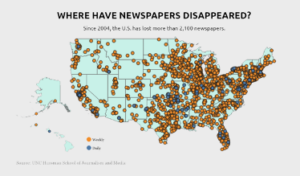What do Glennville, Georgia, and Youngstown, Ohio, have in common? The small town in the Deep South and the mid-sized Midwestern city both have lost their sole local newspapers in recent years.

Residents, without a doubt, sorely miss these local news outlets. The Glennville Sentinel was founded in 1925. The city’s agricultural economy was booming, and there was a lot to report on. But in 2016, the weekly newspaper shut its doors for good, leaving the town of roughly 3,800 and the surrounding area without any local newspaper at all. Youngstown’s 150-year-old daily Vindicator had a similar cult following. After its demise in 2019, a few staffers tried to compensate by launching their own digital news startup. A noble effort, subscribers say, but just not the same.
These are two tales of the death of local news. There are thousands more in the U.S., from the Bald Knob Banner in rural White County, Arkansas, to Hernando Today in Hernando, Florida, to the Rocky Mountain News in Denver, Colorado. A similar pattern is visible in countries around the world. The resulting landscape is increasingly prominent. And it’s become both a cause for concern and for action. Academics have even coined a term for it. Communities, either rural or urban, with limited access to the sort of credible and comprehensive news and information that feeds democracy at the grassroots level, are dubbed “news deserts.”
The desert is spreading rapidly. Between January 2005 and December 2020, a quarter of all U.S. local print newspapers ceased publication, according to data that Northwestern professor Penny Muse Abernathy collected while at the University of North Carolina. Within that same time frame, more than half of all local journalists lost their jobs, as round after round of layoffs gutted newsrooms, according to UNC. The Covid-19 pandemic has accelerated this consolidation. At least 30 more American newspapers closed or merged between April and May 2020 alone.
This trend isn’t limited to the U.S. The influential German regional newspaper Rhein-Zeitung permanently closed all local editorial offices in February 2020, leaving editors at just three locations throughout the entire state of North Rhine-Westphalia. The consolidation mirrors developments in rural, suburban, and urban areas throughout the country.
“In the past, when you were growing up and you got the hometown newspaper, your mom was cutting out the grocery coupons, your dad was reading the sports scores, and you got the local news along with it,” says Anne Nelson, an American journalist and author of the book Shadow Network: Media, Money, and the Secret Hub of the Radical Right. “Sometimes the national and international news came last, but local events and statehouse politics were covered,” Nelson says. “Now, there’s a new political media model exploiting local news deserts particularly in rural, middle America. Americans today inhabit parallel media silos, divided largely along party lines.”
In other words: the decline in local journalism affects the health of local democracy. The news void is filled with cable channels, radio stations, and social media sites that stoke conflict and polarization. In the 2019 study, “When newspapers close, voters become more partisan,” a group of University of Chicago researchers directly and unequivocally linked newspaper closures to partisanship. “Unless something is done,” the study’s authors warned, “our politics will likely become ever more contentious and partisan as the media landscape consolidates.”
That’s the bad news. Here’s a bit of good news. Unique initiatives are pushing back in support of local news. In Boulder, Colorado, for one, the member-supported Public News Service provides multi-platform content for free to news outlets in flyover states in an effort to advocate journalism in the public interest.
Report for America places young journalists in local newsrooms to report on under-covered topics and communities. Aiming to tackle news deserts at scale, it paired 226 reporters with newsrooms in 48 states, Washington, D.C., and Puerto Rico in 2020 compared with just three reporters in 2017. Journalists have worked in newsrooms from Morgantown, West Virginia, to Anchorage, Alaska, and Ridgeland, Mississippi, to name just a few. And in Pittsfield, Massachusetts, a group of local investors took over the Berkshire Eagle from Digital First Media in 2016 in an effort to revive local journalism. Under the new ownership, it hired additional staff and expanded its investigative team. It is now considered a newspaper of record for the entire county.
Perhaps even the simplest of efforts can make a difference. In 2019, the editor of The Desert Sun, a local daily in Palm Springs, California, dropped national politics from the opinion page for a month. As op-eds turned to local issues, so did the news. Online readership nearly doubled. And academics who analyzed the experiment found that polarization in Palm Springs had visibly decreased. “Polarization is a tough trend to slow down in American politics,” says Joshua Darr, a professor at Louisiana State University. “But The Desert Sun was able to do just that by changing one page of its paper per day.”
4,609 Total Views, 12 Views Today






